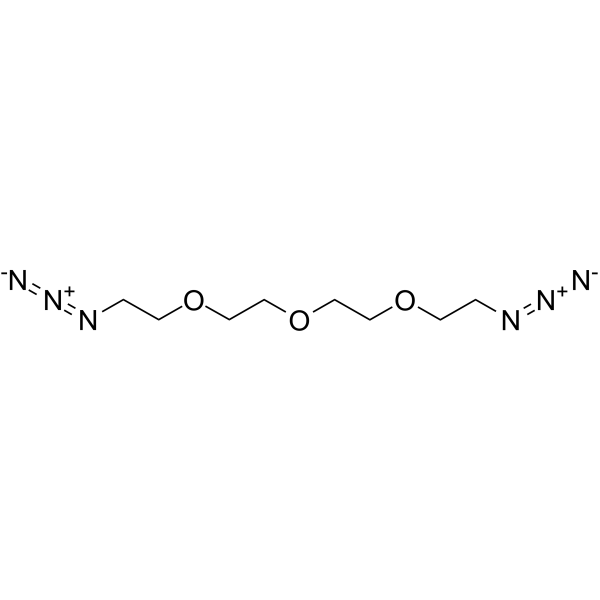
Azido-PEG3-azide
CAS No. 101187-39-7
Azido-PEG3-azide( —— )
Catalog No. M26896 CAS No. 101187-39-7
Azido-PEG3-azide is a PEG-based PROTAC linker that can be used in the synthesis of PROTACs.
Purity : >98% (HPLC)
 COA
COA
 Datasheet
Datasheet
 HNMR
HNMR
 HPLC
HPLC
 MSDS
MSDS
 Handing Instructions
Handing Instructions
| Size | Price / USD | Stock | Quantity |
| 50MG | 38 | Get Quote |


|
| 100MG | 59 | Get Quote |


|
| 200MG | Get Quote | Get Quote |


|
| 500MG | Get Quote | Get Quote |


|
| 1G | Get Quote | Get Quote |


|
Biological Information
-
Product NameAzido-PEG3-azide
-
NoteResearch use only, not for human use.
-
Brief DescriptionAzido-PEG3-azide is a PEG-based PROTAC linker that can be used in the synthesis of PROTACs.
-
DescriptionAzido-PEG3-azide is a PEG-based PROTAC linker that can be used in the synthesis of PROTACs.(In Vitro):PROTACs contain two different ligands connected by a linker; one is a ligand for an E3 ubiquitin ligase and the other is for the target protein. PROTACs exploit the intracellular ubiquitin-proteasome system to selectively degrade target proteins.
-
In VitroPROTACs contain two different ligands connected by a linker; one is a ligand for an E3 ubiquitin ligase and the other is for the target protein. PROTACs exploit the intracellular ubiquitin-proteasome system to selectively degrade target proteins.
-
In Vivo——
-
Synonyms——
-
PathwayOthers
-
TargetOther Targets
-
Recptor——
-
Research Area——
-
Indication——
Chemical Information
-
CAS Number101187-39-7
-
Formula Weight244.255
-
Molecular FormulaC8H16N6O3
-
Purity>98% (HPLC)
-
SolubilityIn Vitro:?DMSO : 100 mg/mL (409.42 mM)
-
SMILES[N-]=[N+]=NCCOCCOCCOCCN=[N+]=[N-]
-
Chemical Name——
Shipping & Storage Information
-
Storage(-20℃)
-
ShippingWith Ice Pack
-
Stability≥ 2 years
Reference
molnova catalog



related products
-
Valosin Peptide (VQY...
Valosin (porcine) is a biologically active peptide with 25-amino-acid. Valosin (porcine) can be isolated recently from pig intestine. Valosin (porcine) can be used for the research of digestive system.
-
(S,R,S)-AHPC-C10-NH2
(S,R,S)-AHPC-C10-NH2 is a synthesized E3 ligase ligand-linker conjugate incorporating the (S,R,S)-AHPC based VHL ligand and a linker used for BET-Targeted PROTAC.
-
Thalidomide-O-amido-...
Thalidomide-O-amido-PEG-C2-NH2 hydrochloride, a synthesized E3 ligase ligand-linker conjugate that incorporates the Thalidomide based cereblon ligand and a linker, can be used in the synthesis of PROTACs.



 Cart
Cart
 sales@molnova.com
sales@molnova.com


